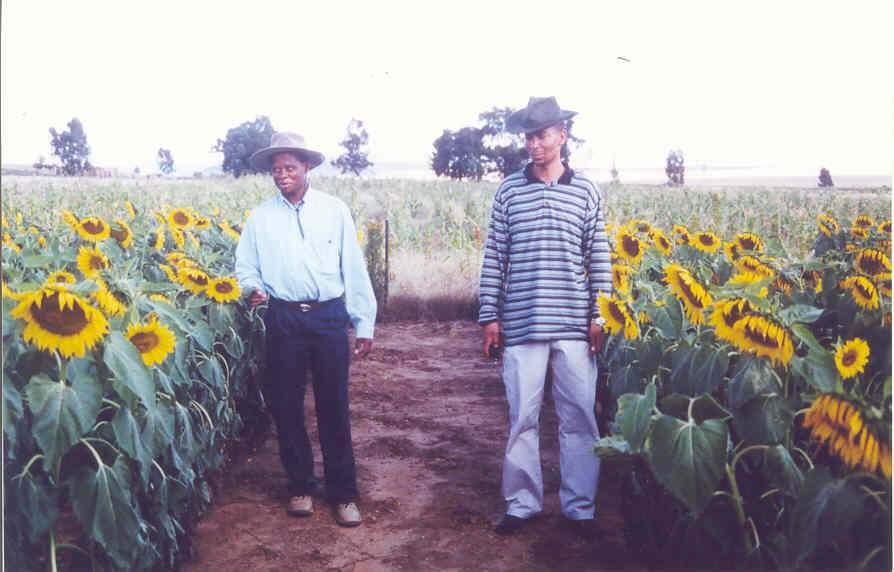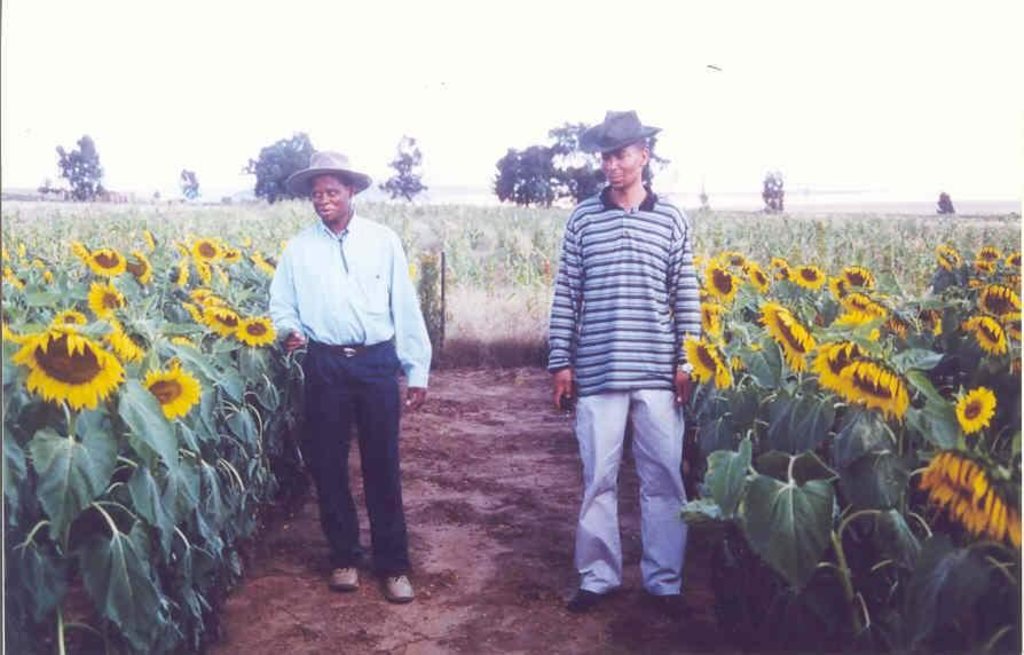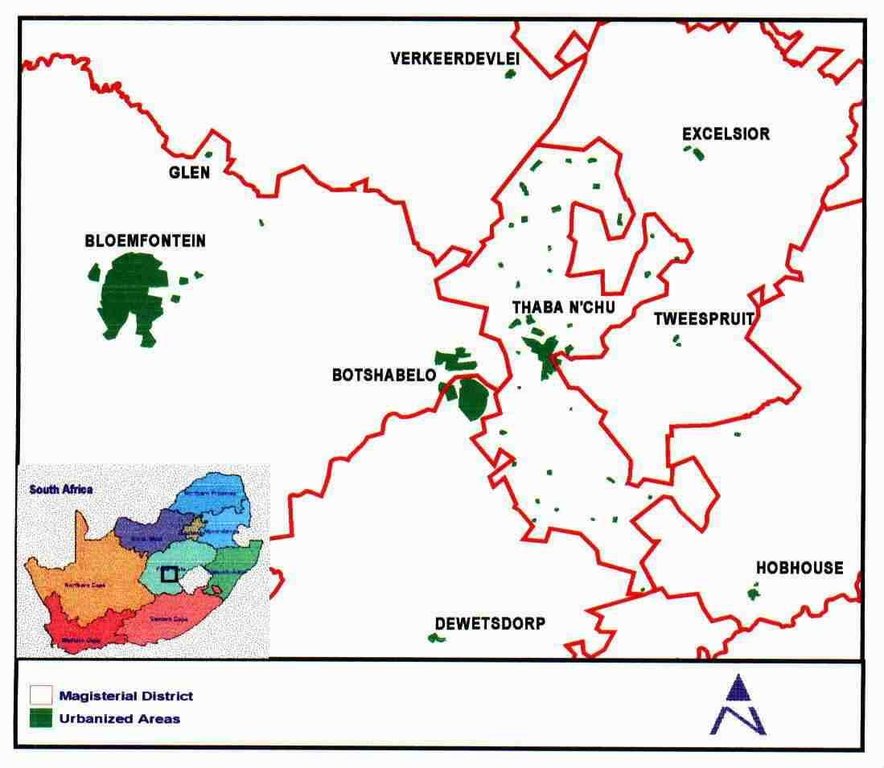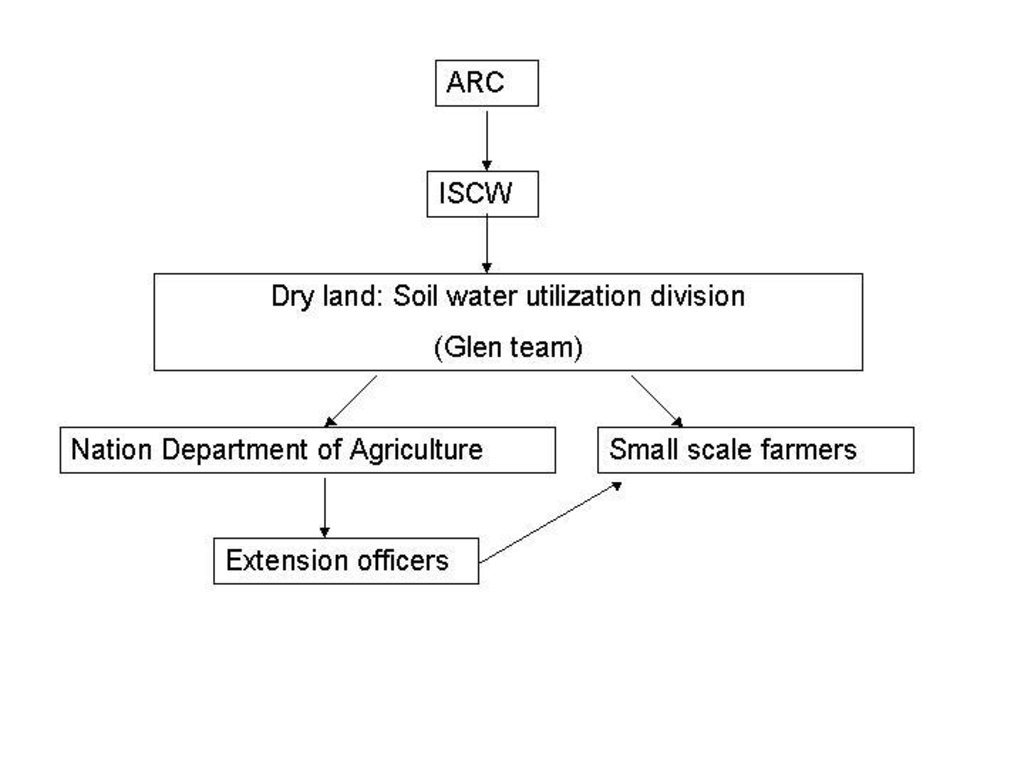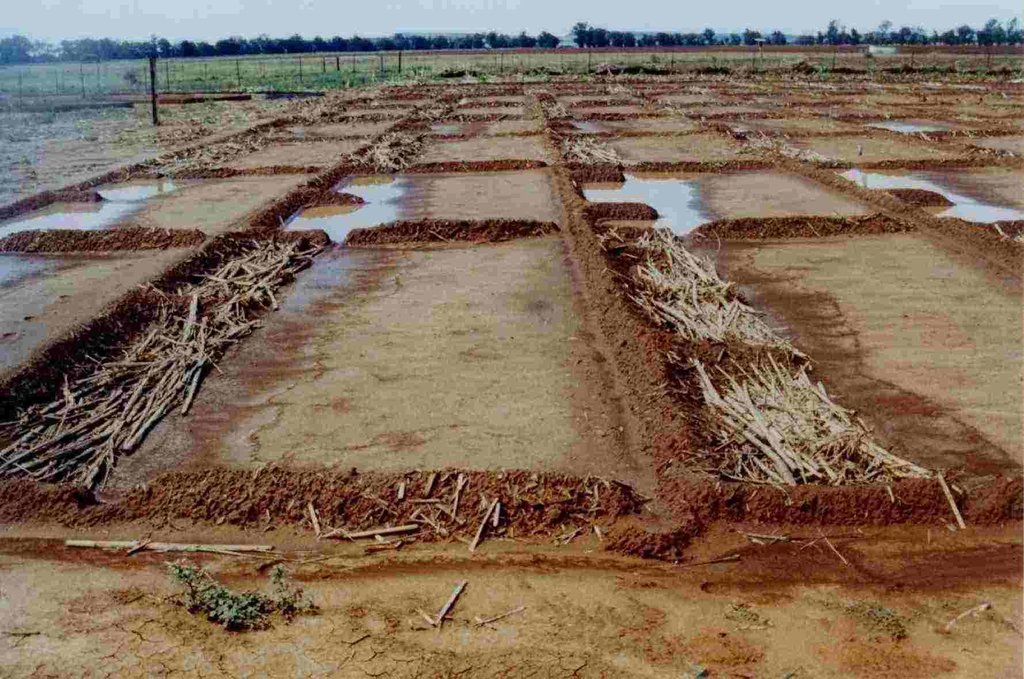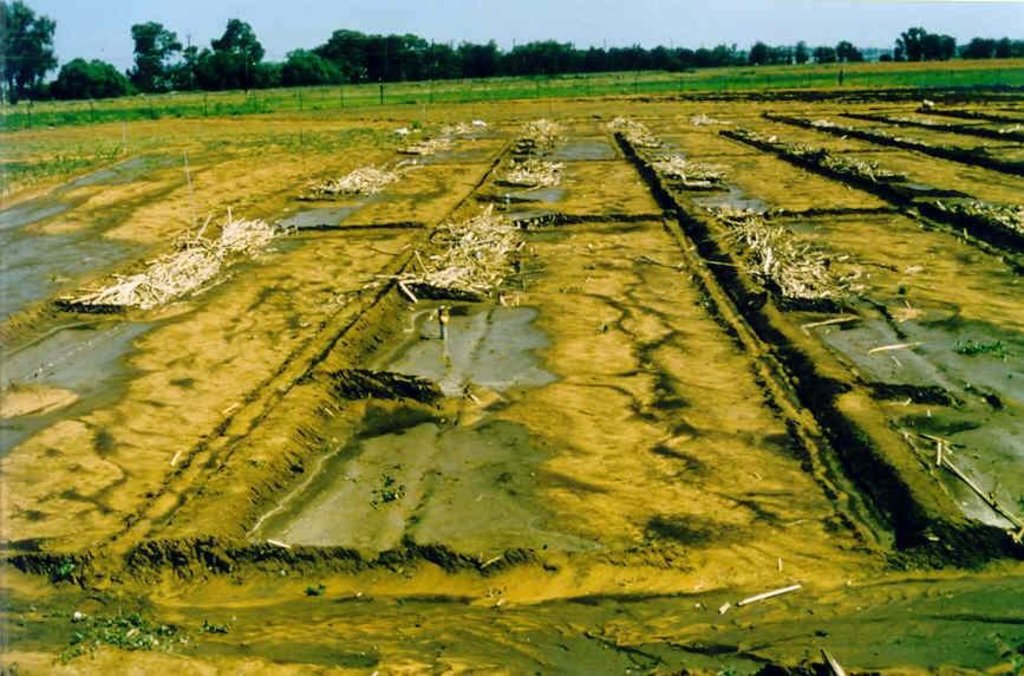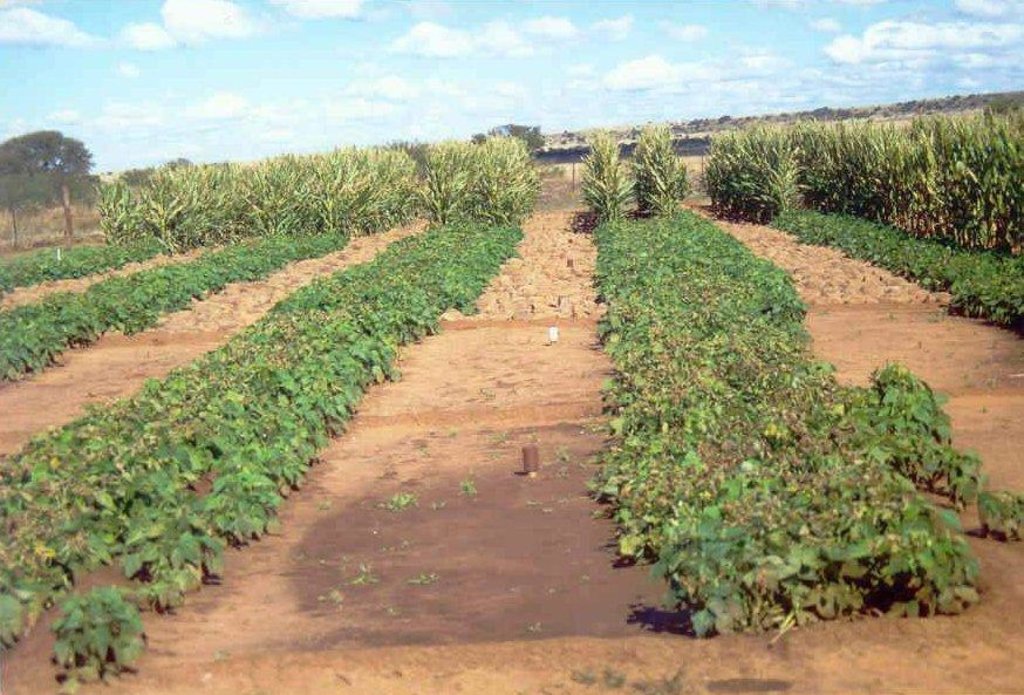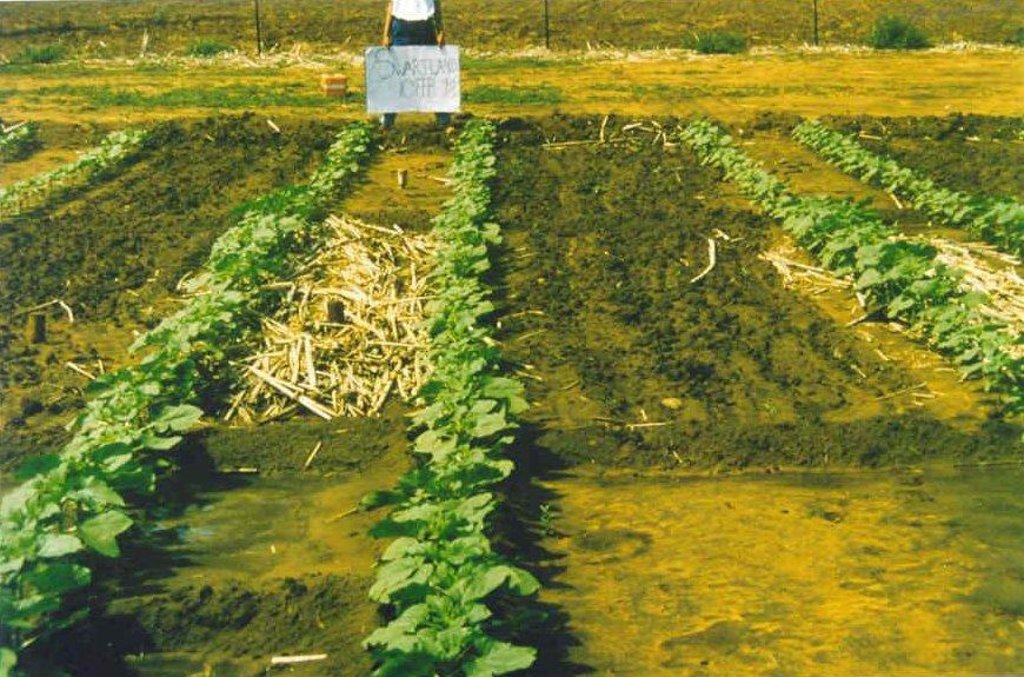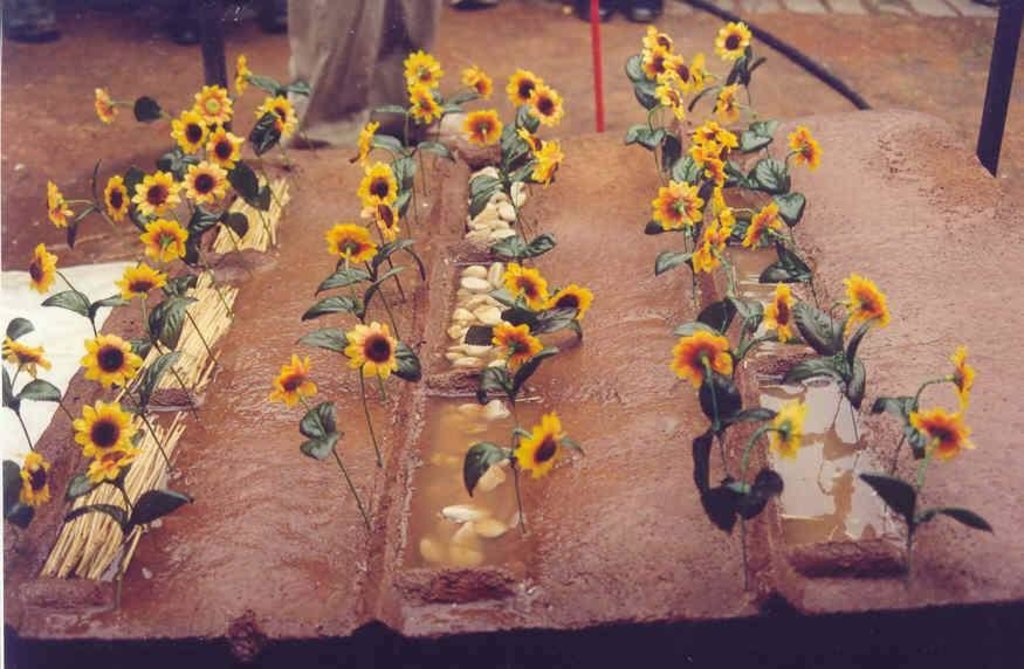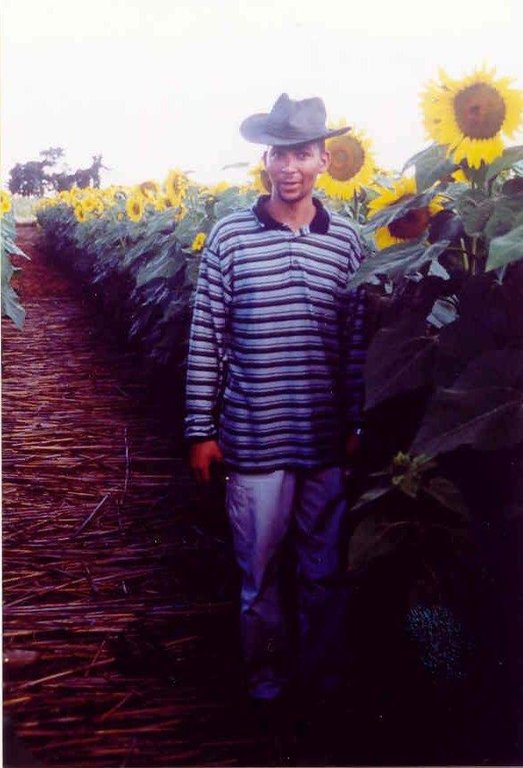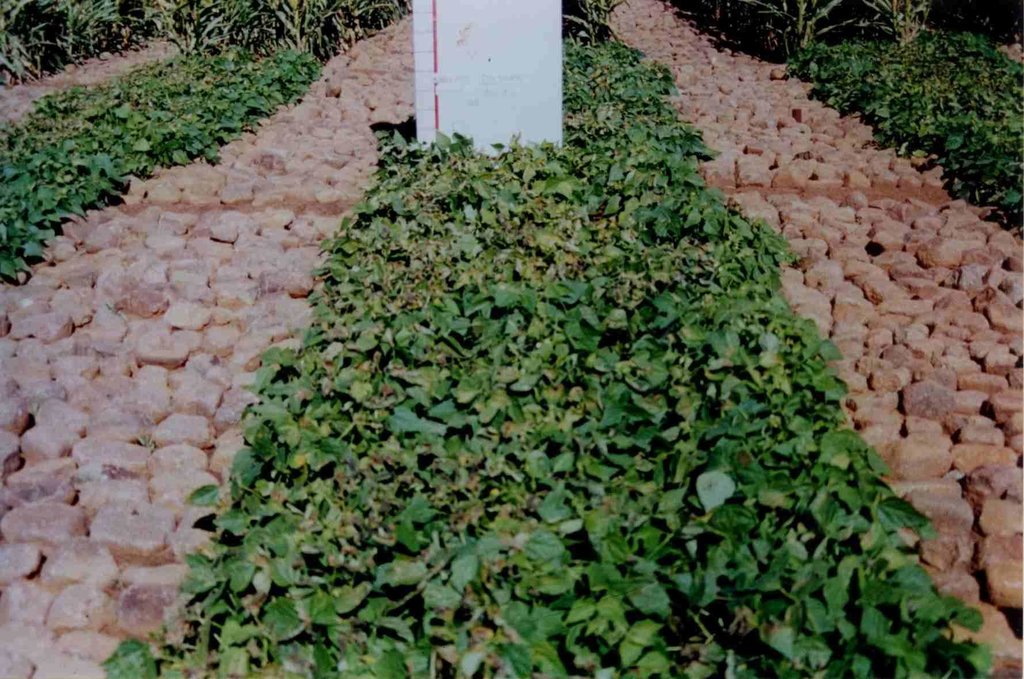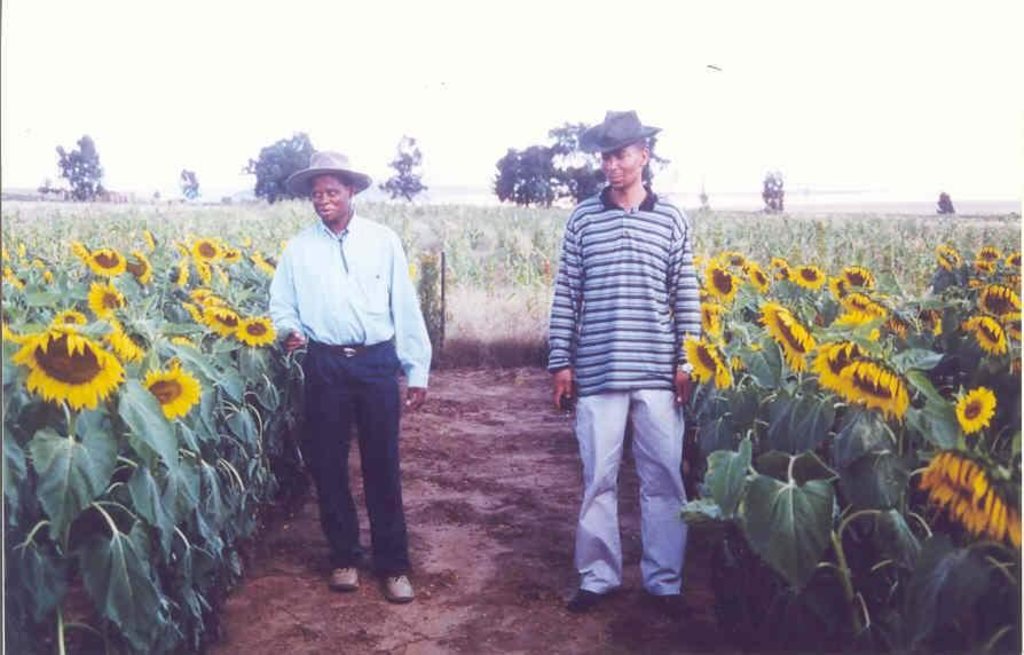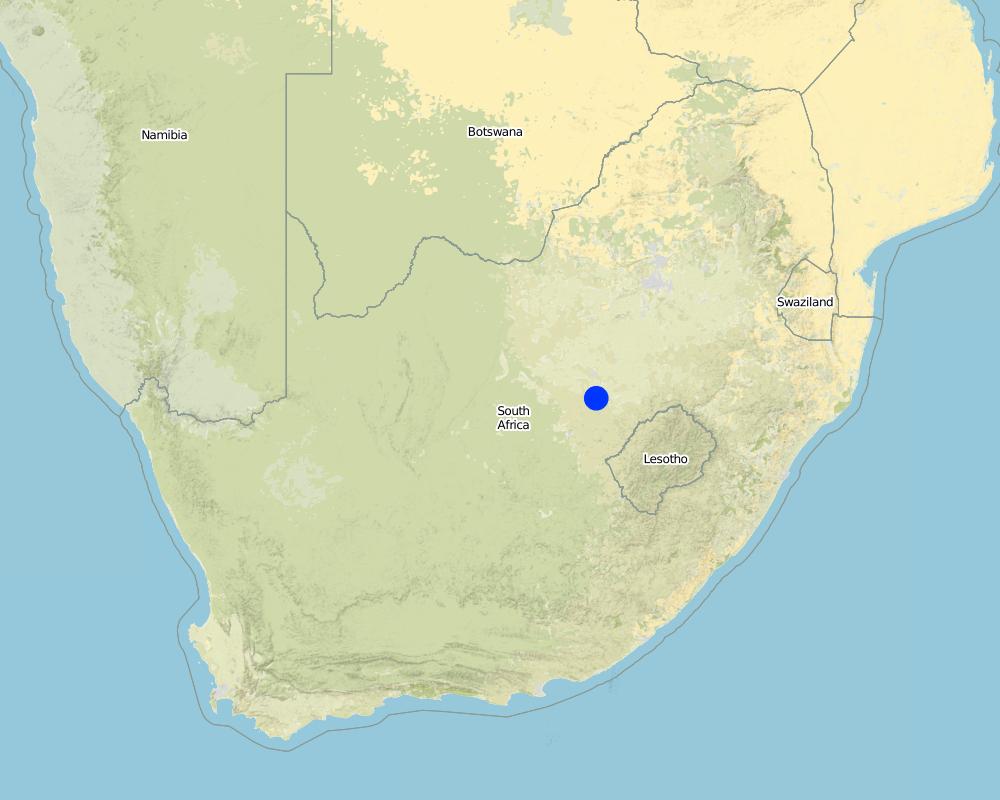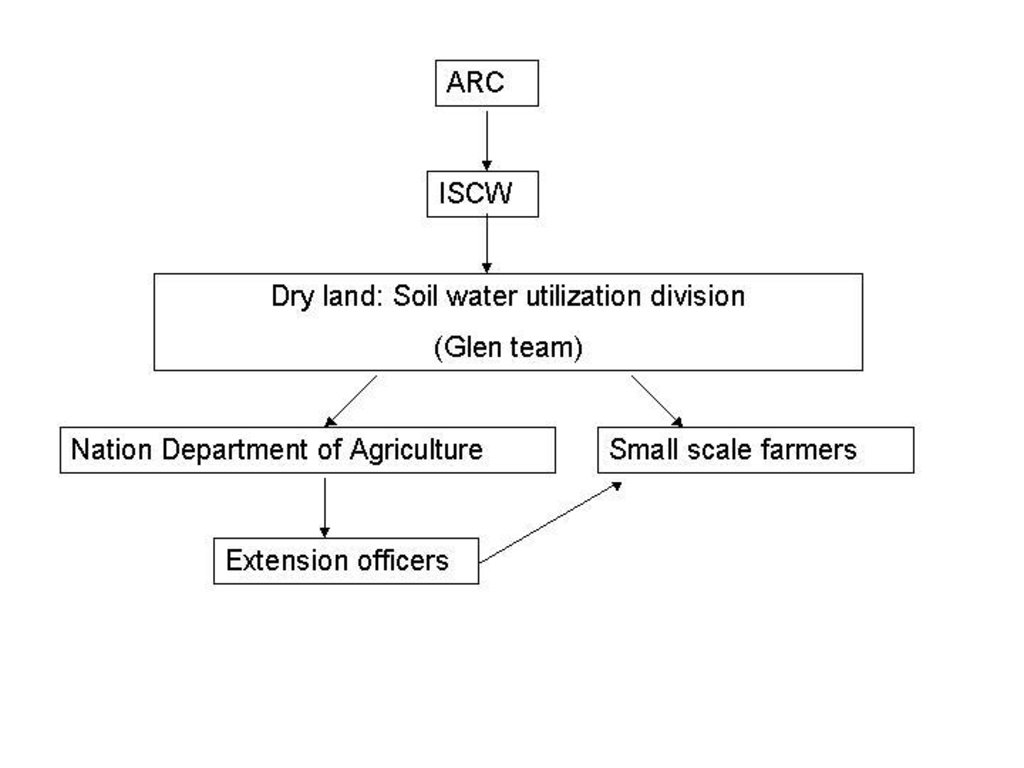Water Harvesting & Basin tillage (WHB) through demonstrations [África do Sul]
- Criação:
- Atualização:
- Compilador/a: Cobus Botha
- Editor: –
- Revisor: Fabian Ottiger
approaches_2336 - África do Sul
Veja as seções
Expandir tudo Recolher tudo1. Informação geral
1.2 Detalhes do contato das pessoas capacitadas e instituições envolvidas na avaliação e documentação da abordagem
1.3 Condições em relação ao uso da informação documentada através de WOCAT
O/a compilador/a e a(s) pessoa(s) capacitada(s) aceitam as condições relativas ao uso de dados documentados através da WOCAT:
Sim
1.4 Referência ao(s) questionário(s) sobre tecnologias da GST
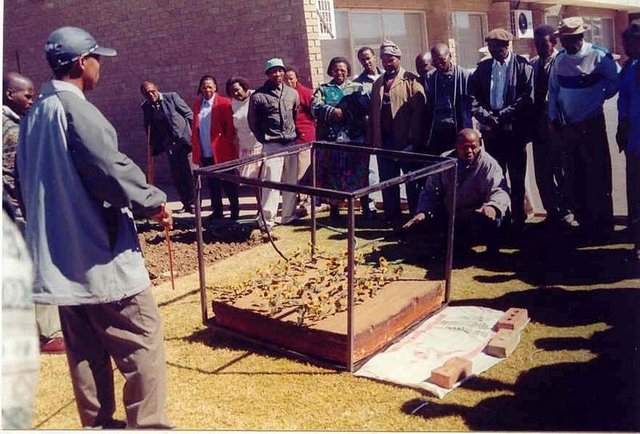
Water Harvesting & Basin tillage [África do Sul]
In-field water harvesting technique
- Compilador/a: Cobus Botha
2. Descrição da abordagem de GST
2.1 Descrição curta da abordagem
Optimising rainwater use, reduce runoff by use of basins and reduce evaporation losses by applying a mulch (stone/reeds) on the runoff strip and in the basins.
2.2 Descrição detalhada da abordagem
Descrição detalhada da abordagem:
Aims / objectives: Given the marginal soils of a clayey nature and/or slope terrain, coupled with erratic rainfall events, the technology aims to harvest available rain water and prevent runoff and soil loss. At present, PRAs are conducted in target areas and so far, people are eager to adopt the technology. The aim is to train them and assist in constructing the basins so that after a year they will be able to take over the project entirely even though the team will still be around to provide advice should the need arise.
2.3 Fotos da abordagem
2.5 País/região/locais onde a abordagem foi aplicada
País:
África do Sul
Região/Estado/Província:
Free State
Map
×2.6 Datas de início e término da abordagem
Indique o ano de início:
1996
Ano de término (caso a abordagem não seja mais aplicada):
2002
2.7 Tipo de abordagem
- Baseado em projeto/programa
2.8 Principais metas/objetivos da abordagem
The Approach focused on SLM only (n/a)
*To make optimal use of pre-plant water that collects in basins from summer rains that fall during the fallow period. Saved water very beneficial during the reproductive growth of plants which often occurs when there is no rain.
*Prevention of soil and water loss through water erosion and runoff by the use of basins.
*Restriction of evaporation by the use of mulch. Straw is mostly preferred for its biodegradability although stone in comparative percentage cover is more effective.
The SLM Approach addressed the following problems: The target areas are marginal for crop production because of relatively low and erratic rainfall and dominantly clay soils on which the precipitation use efficiency is low because of high losses due to runoff and evaporation form the soul surface.
2.9 Condição que propiciam ou inibem a implementação de tecnologia/tecnologias aplicada(s) segundo a abordagem
Normas e valores sociais/culturais/religiosos
- Inibitivo
People are resistant to change. Had to convince that they can get better yields with new technique.
Treatment through the SLM Approach: Interacting with people as much as possible and comparing yields on farmers days after harvest.
Disponibilidade/acesso a recursos e serviços financeiros
- Inibitivo
Most can't afford inputs and to hire labour for construction of basins.
Treatment through the SLM Approach: Team will ask for discounts from providers and encourage team work amongst community.
Quadro jurídico (posse de terra, direitos de uso da terra e da água)
- Propício
The existing land ownership, land use rights / water rights greatly helped the approach implementation: Land owners have little deeds and no law inhibits them from actively participating in the project.
3. Participação e papel das partes interessadas envolvidas
3.1 Partes interessadas envolvidas na abordagem e seus papéis
- Usuários de terra/comunidades locais
Land owners and local chiefs. Approach can only be implemented with their acceptance and approval. Specific ethnic groups: Black, resource poor farmers
Women tend to be submissive and docile. They look up to the men for decision making.
- Especialistas em GST/ consultor agrícola
- Governo nacional (planejadores, responsáveis pelas decisões)
- Organização internacional
ARC - ISCW
3.2 Envolvimento do usuários de terra/comunidades locais nas diferentes fases da abordagem
| Envolvimento do usuários de terra/comunidades locais | Especifique quem estava envolvido e descreva as atividades | |
|---|---|---|
| Iniciação/motivação | Nenhum | rapid/participatory rural appraisal |
| Planejamento | Nenhum | |
| Implementação | Passivo | casual labour |
| Monitoramento/avaliação | Participativo | |
| Research | Nenhum | on-farm; On-station experiments are conducted at Glen to evaluate different SWC techniques. The new technology is transferred by means of on-farm demonstration plots and information days. |
3.3 Fluxograma (se disponível)
3.4 Decisão sobre a seleção de tecnologia/tecnologias de GST
Especifique quem decidiu sobre a seleção de tecnologia/tecnologias a serem implementadas:
- Somente especialistas em GST
Explique:
land user driven (bottom-up). Realisation of poverty.
Decisions on the method of implementing the SLM Technology were made by mainly by land users supported by SLM specialists. land user driven (bottom-up). The need of land users to alleviate poverty.
4. Suporte técnico, reforço das capacidades e gestão do conhecimento
4.1 Reforço das capacidades/ formação
Foi oferecida formação aos usuários da terra/outras partes interessadas?
Sim
Especifique quem foi capacitado:
- Usuários de terra
- extensionists/trainers
Tipo de formação:
- Áreas de demonstração
- Reuniões públicas
Assuntos abordados:
Construction of basins; better understanding of the system in simple terms; the concept of infiltration, evapotranspiration; erosion and runoff.
4.2 Serviço de consultoria
Os usuários de terra têm acesso a um serviço de consultoria?
Sim
Especifique se foi oferecido serviço de consultoria:
- Em centros permanentes
Descreva/comentários:
NDA Extension; Key elements: Assistance in technology transfer, Organising public meetings, Establishing & link between specialists and land users;
1) Advisory service was carried out through: government's existing extension system. Extension staff: mainly government employees
2) Target groups for extension: land users; Activities: Technology transfer
Advisory service is quite adequate to ensure the continuation of land conservation activities; With a little persuasion, they assist completely.
4.3 Fortalecimento da instituição (desenvolvimento organizacional)
As instituições foram fortalecidas ou estabelecidas através da abordagem?
- Sim, pouco
Especifique a que nível (níveis) as instituições foram fortalecidas ou estabelecidas:
- Local
Especifique o tipo de apoio:
- Reforço das capacidades/ formação
4.4 Monitoramento e avaliação
Monitoramento e avaliação são partes da abordagem?
Sim
Comentários:
bio-physical aspects were regular monitored through measurements
socio-cultural aspects were None monitored through measurements
economic / production aspects were None monitored through measurements
There were few changes in the Approach as a result of monitoring and evaluation: An organic mulch can be placed in the basins and on the runoff strip to stop evaporation losses. However cattle are allowed to graze in the land after the crop has been harvested. There after there is almost no organic mulch left to cover the soil surface. Stones were then suggested as an alternative mulch.
4.5 Pesquisa
A pesquisa foi parte da abordagem?
Sim
Especifique os tópicos:
- Sociologia
- Economia/Marketing
- Tecnologia
Dê mais detalhes e indique quem realizou a pesquisa:
Research was carried out both on station and on-farm
5. Financiamento e apoio material externo
5.1 Orçamento anual para o componente de GST da abordagem
Caso o orçamento exato seja desconhecido, indique a faixa:
- 100.000-1.000.000
Comentários (p. ex. principais fontes de recursos/principais doadores):
Approach costs were met by the following donors: national non-government (Water Research Commission): 100.0%
5.2 Apoio financeiro/material concedido aos usuários da terra
Os usuários da terra receberam apoio financeiro/material para a implementação de tecnologia/tecnologias?
Sim
5.3 Subsídios para entradas específicas (incluindo mão-de-obra)
- Equipamento
| Especifique quais entradas foram subsidiadas | Em que medida | Especifique os subsídios |
|---|---|---|
| Maquinário | Totalmente financiado | |
| Ferramentas | Totalmente financiado | |
- Agrícola
| Especifique quais entradas foram subsidiadas | Em que medida | Especifique os subsídios |
|---|---|---|
| Sementes | Totalmente financiado | |
| Fertilizantes | Totalmente financiado | |
| Biocides | Totalmente financiado | |
Se a mão-de-obra pelos usuários da terra foi uma entrada substancial, isso foi:
- Pago em dinheiro
6. Análise de impactos e declarações finais
6.1 Impactos da abordagem
A abordagem auxiliou os usuários da terra a implementar e manter as tecnologias de GST?
- Não
- Sim, pouco
- Sim, moderadamente
- Sim, significativamente
N/A N/A
Did other land users / projects adopt the Approach?
- Não
- Sim, pouco
- Sim, moderadamente
- Sim, significativamente
Team about to start a food security project adopting the WHB.
6.3 Atividades de sustentabilidade de abordagem
Os usuários da terra podem manter o que foi implementado através da abordagem (sem apoio externo)?
- Sim
6.4 Pontos fortes/vantagens da abordagem
| Pontos fortes/vantagens/oportunidades na visão do usuário da terra |
|---|
| Produced higher yields. |
| Pontos fortes/vantagens/oportunidades na visão do/a compilador/a ou de outra pessoa capacitada |
|---|
| Success of the WHB technique depends on suppressing water losses by runoff (R) and evaporation from the soil surface (Es). Measurements show that R has been reduced to zero and that Es has been reduced considerable, but still remains a serious avenue for water loss. (How to sustain/ enhance this strength: Future experimentation needs to focus on suppressing Es by any possible means.) |
| The WHB treatment gives considerably better yields than the conventional treatment. (How to sustain/ enhance this strength: Results from more seasons are needed to quantify the extent of this difference in a reliable way.) |
| Save on cultivation costs since no-till is employed. |
| The WHB technique is ell suited for use on very small pots, and even in townships. Many people in semi-arid areas could be usefully employed if this technique was widely adapted, and food security could be increased at the same time. (How to sustain/ enhance this strength: Extension work in this connection by the PSDA needs to be encourage.) |
| Soil loss from the land as a whole is zero. This is an important advantage over the conventional tillage in terms of sustainability. |
6.5 Pontos fracos, desvantagens da tecnologia e formas de superá-los
| Pontos fracos/desvantagens/riscos na visão do usuário da terra | Como eles podem ser superados? |
|---|---|
| It is labour intensive to initially construct the basins, by hand. |
| Pontos fracos/vantagens/riscos na visão do/a compilador/a ou de outra pessoa capacitada | Como eles podem ser superados? |
|---|---|
| There is some soil movement form the runoff area into the basins, ad basins may silt up over time. | |
| Huge storms may overflow and break basin walls; and basins may need some maintenance. | |
| In the case of small rainfall events all the water may not reach the basins. | |
| Organic mulch may act as a sponge and absorb some of the rainwater. |
7. Referências e links
7.1 Métodos/fontes de informação
- visitas de campo, pesquisas de campo
- entrevistas com usuários de terras
7.2 Referências às publicações disponíveis
Título, autor, ano, ISBN:
Optimising rainfall use efficiency for developing farmers with limited access to irrigation water, WRC Report No 878/1/00. Hensley, M; Botha, JJ; Anderson, JJ; Van Staden, PP & Du Toit, A. 2000Video 'In field Rainwater harvesting (1) Basic concepts to ensure agronomic and conservation sustainability in small scale farming'.The video illustrates the existing results obtained to enhance agronomic and conservation sustainability.
Disponível de onde? Custos?
R120. Leon van Rensburg, P/B X01, Glen, 9360. Debruint@glen.agric.za
Título, autor, ano, ISBN:
Optimising rainfall use efficiency for developing farmers with limited access to irrigation water, WRC Report No 878/1/00. Hensley, M; Botha, JJ; Anderson, JJ; Van Staden, PP & Du Toit, A. 2000
Título, autor, ano, ISBN:
Video 'In field Rainwater harvesting (1) Basic concepts to ensure agronomic and conservation sustainability in small scale farming'.
Links e módulos
Expandir tudo Recolher tudoLinks

Water Harvesting & Basin tillage [África do Sul]
In-field water harvesting technique
- Compilador/a: Cobus Botha
Módulos
Não há módulos


